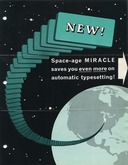One difficulty with automating a Linotype or Intertype is that a machine running under automatic control didn't have an operator present to correct the various small problems which could arise. The machine therefore had to be "instrumented" to sense these problems. Devices such as Mergenthaler's Electromatic Safety detected problems with mats getting stuck. The Shaffstall mat detector addressed a different issue: mats failing to drop from the magazine.
It employed a light and photocell detector to scan the Assembler Entrance to detect each mat falling. It counted mats as they fell and checked these against the Teletypesetter tape. If a mat failed to fall, it stopped the machine (so that the line could not cast) and alerted a machine attendant who could then manually correct the problem.
Fairchild also made a similar mat detector for use with the Teletypesetter.

NEW! Space-age MIRACLE
NEW! Space-age MIRACLE saves you even more on automatic typesetting!

Shaffstall Transistor Mat Detector Manual
Transistor Mat Detector Manual[:] Installation Instructions and Trouble Diagnosis . (Indianapolis, IN: Shaffstall Equipment, Inc., May 1965). and Parts List for Transistor Mat Detector[,] Models 600 through 2000 (Indianapolis, IN: Shaffstall Equipment, Inc., December 1964). This is online at Dave Hughes' MetalType.co.uk

Shaffstall US Patent 2,955,703
US patent 2,955,703. 1960-10-11. Everett G. Shaffstall. "Mat Detector for Slug Linecasting Machines." This appears to be the basic patent for the mat detector. It is for a tube-controlled (not transistorized) machine. The copy here is a PDF generated from the USPTO image files. A much nicer version (with the presentation page in color, ribbon and all) is online at Dave Hughes' MetalType.co.uk
The All of the Shaffstall documents reprinted here were published in the US without copyright notice at times when such notice ws required to secure copyright. They therefore passed into the public domain upon initial publication. The digital reprints of them here remain in the public domain.
All portions of this document not noted otherwise are Copyright © 2010 by David M. MacMillan and Rollande Krandall.
Circuitous Root is a Registered Trademark of David M. MacMillan and Rollande Krandall.
This work is licensed under the Creative Commons "Attribution - ShareAlike" license. See http://creativecommons.org/licenses/by-sa/3.0/ for its terms.
Presented originally by Circuitous Root®
Select Resolution: 0 [other resolutions temporarily disabled due to lack of disk space]